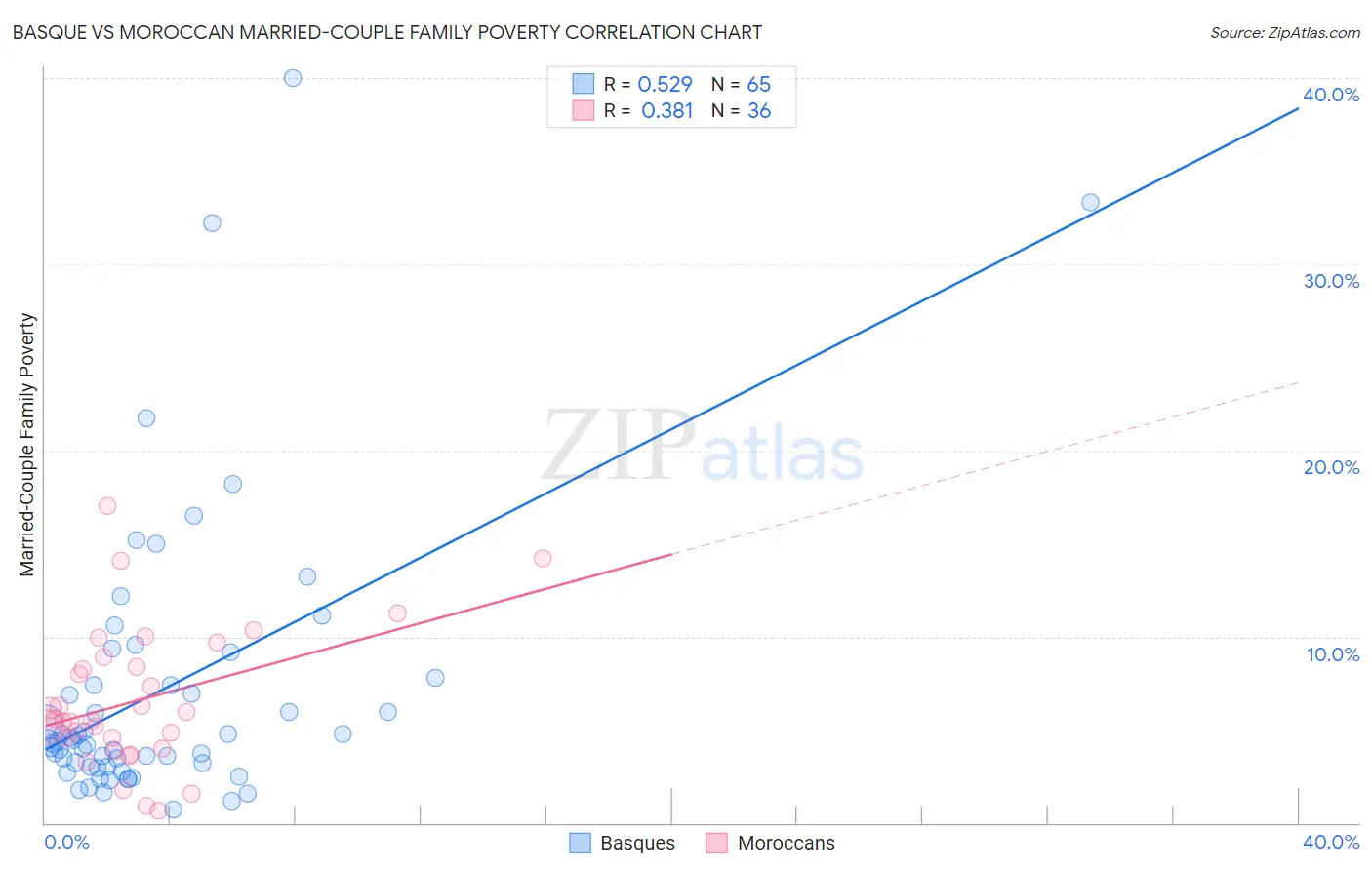Basque vs Moroccan Married-Couple Family Poverty
COMPARE
Basque
Moroccan
Married-Couple Family Poverty
Married-Couple Family Poverty Comparison
Basques
Moroccans
4.6%
MARRIED-COUPLE FAMILY POVERTY
98.5/ 100
METRIC RATING
91st/ 347
METRIC RANK
5.7%
MARRIED-COUPLE FAMILY POVERTY
4.9/ 100
METRIC RATING
230th/ 347
METRIC RANK
Basque vs Moroccan Married-Couple Family Poverty Correlation Chart
The statistical analysis conducted on geographies consisting of 165,263,383 people shows a substantial positive correlation between the proportion of Basques and poverty level among married-couple families in the United States with a correlation coefficient (R) of 0.529 and weighted average of 4.6%. Similarly, the statistical analysis conducted on geographies consisting of 200,993,893 people shows a mild positive correlation between the proportion of Moroccans and poverty level among married-couple families in the United States with a correlation coefficient (R) of 0.381 and weighted average of 5.7%, a difference of 23.6%.

Married-Couple Family Poverty Correlation Summary
| Measurement | Basque | Moroccan |
| Minimum | 0.72% | 0.64% |
| Maximum | 40.0% | 17.0% |
| Range | 39.3% | 16.4% |
| Mean | 7.1% | 6.6% |
| Median | 4.4% | 5.6% |
| Interquartile 25% (IQ1) | 3.0% | 4.3% |
| Interquartile 75% (IQ3) | 7.6% | 8.6% |
| Interquartile Range (IQR) | 4.6% | 4.3% |
| Standard Deviation (Sample) | 7.6% | 3.7% |
| Standard Deviation (Population) | 7.6% | 3.7% |
Similar Demographics by Married-Couple Family Poverty
Demographics Similar to Basques by Married-Couple Family Poverty
In terms of married-couple family poverty, the demographic groups most similar to Basques are Immigrants from Switzerland (4.6%, a difference of 0.040%), Immigrants from Norway (4.6%, a difference of 0.080%), Immigrants from Czechoslovakia (4.6%, a difference of 0.11%), Bolivian (4.6%, a difference of 0.22%), and Korean (4.6%, a difference of 0.26%).
| Demographics | Rating | Rank | Married-Couple Family Poverty |
| Immigrants | Croatia | 98.7 /100 | #84 | Exceptional 4.6% |
| South Africans | 98.7 /100 | #85 | Exceptional 4.6% |
| Immigrants | Turkey | 98.6 /100 | #86 | Exceptional 4.6% |
| Immigrants | North Macedonia | 98.6 /100 | #87 | Exceptional 4.6% |
| Bolivians | 98.6 /100 | #88 | Exceptional 4.6% |
| Immigrants | Czechoslovakia | 98.5 /100 | #89 | Exceptional 4.6% |
| Immigrants | Switzerland | 98.5 /100 | #90 | Exceptional 4.6% |
| Basques | 98.5 /100 | #91 | Exceptional 4.6% |
| Immigrants | Norway | 98.4 /100 | #92 | Exceptional 4.6% |
| Koreans | 98.3 /100 | #93 | Exceptional 4.6% |
| Immigrants | Italy | 98.3 /100 | #94 | Exceptional 4.6% |
| Portuguese | 98.3 /100 | #95 | Exceptional 4.6% |
| Immigrants | Poland | 98.3 /100 | #96 | Exceptional 4.6% |
| Immigrants | Belgium | 98.2 /100 | #97 | Exceptional 4.6% |
| Native Hawaiians | 98.0 /100 | #98 | Exceptional 4.6% |
Demographics Similar to Moroccans by Married-Couple Family Poverty
In terms of married-couple family poverty, the demographic groups most similar to Moroccans are Subsaharan African (5.7%, a difference of 0.030%), Immigrants from Iraq (5.7%, a difference of 0.26%), Arab (5.7%, a difference of 0.28%), Immigrants from Laos (5.7%, a difference of 0.32%), and Immigrants from Zaire (5.6%, a difference of 0.41%).
| Demographics | Rating | Rank | Married-Couple Family Poverty |
| Immigrants | Fiji | 6.7 /100 | #223 | Tragic 5.6% |
| Sudanese | 6.4 /100 | #224 | Tragic 5.6% |
| Immigrants | Cambodia | 6.1 /100 | #225 | Tragic 5.6% |
| South Americans | 5.7 /100 | #226 | Tragic 5.6% |
| Immigrants | Zaire | 5.6 /100 | #227 | Tragic 5.6% |
| Arabs | 5.4 /100 | #228 | Tragic 5.7% |
| Sub-Saharan Africans | 4.9 /100 | #229 | Tragic 5.7% |
| Moroccans | 4.9 /100 | #230 | Tragic 5.7% |
| Immigrants | Iraq | 4.4 /100 | #231 | Tragic 5.7% |
| Immigrants | Laos | 4.4 /100 | #232 | Tragic 5.7% |
| Immigrants | Colombia | 3.7 /100 | #233 | Tragic 5.7% |
| Immigrants | Uruguay | 3.7 /100 | #234 | Tragic 5.7% |
| Immigrants | Sudan | 3.5 /100 | #235 | Tragic 5.7% |
| Ghanaians | 3.3 /100 | #236 | Tragic 5.7% |
| Immigrants | South America | 3.1 /100 | #237 | Tragic 5.7% |